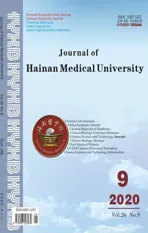Network pharmacology approach on the mechanism of Sanwu Huangqin Decoction in treating Behcet's disease
2020-07-10YongZhuPiaoDaNanSunYanZhangYinShao
Yong-Zhu Piao, Da-Nan Sun, Yan Zhang, Yin Shao✉
1. The First Affiliated Hospital of Heilongjiang University of traditional Chinese medicine, Heilongjiang, Harbin, 150040
2. The Second Affiliated Hospital of Heilongjiang University of traditional Chinese medicine, Harbin, Heilongjiang, 150001 3. Heilongjiang University of traditional Chinese medicine, Heilongjiang, Harbin, 150040
Keywords:Sanwu Huangqin decoction Behcet's disease Network pharmacology Mechanism
ABSTRACT Objective: To analyze the main compounds of Sanwu Huangqin decoction based on the method of network pharmacology and to predict its possible target and mechanism of action in the treatment of Behcet's disease(BD). Methods: TCMSP, TCMID and literatures were used to search the main compounds and their corresponding targets of Sanwu Huangqin Decoction; the disease targets of BD were searched by GeneCards database; the intersection targets of Sanwu Huangqin Decoction and BD were visualized by String database and Cytoscape software; the intersection targets were enriched by GO and KEGG by DAVID database; BD mouse model was established, RT-PCR was used to verify the regulatory effect of Sanwu Huangqin Decoction on the core target genes. Results: A total of 81 main active compounds and 50 drug-disease-target were retrieved from the databases. There were 531 biological function information and 96 signal pathways were enriched by GO and KEGG. Among them, the top 5 signal pathways were Fluid shear stress and atherosclerosis、AGE-RAGE signaling pathway in diabetic complications、IL-17 signaling pathway、TNF signaling pathway、Malaria、Chagas disease (American trypanosomiasis). RT-PCR results showed that the expression of IL-4, IL-1 β, IL-6, INF-γ mRNA in the spleen of BD mice was significantly up-regulated, and the expression of Caspase 3 and Caspase 8 mRNA was significantly down regulated when compared with the control group (P<0.01). Compared with the model group, the expression of IL-4, IL-1 β, IL-6, INF-γ mRNA in the Sanwu Huangqin decoction group was significantly down regulated, and the expression of caspase 3 and caspase 8 mRNA was significantly up regulated (P<0.01). Conclusion: Sanwu Huangqin decoction can treat BD through multi-target and multi-channel therapy, and our study and our research provides bioinformatics basis for further revealing its mechanism and treatment.
1. Introduction
Behcet's disease (BD) is a systemic, chronic and recurrent immune system disease closely related to genetic factors (such as hla-b51 gene), bacterial or viral infection, immune dysfunction and other factors [1]. BD often invades many organs, including the mouth, eyes, skin and muscle joints. Clinically, it is mainly manifested in recurrent oral ulcer, genital ulcer, skin damage and iritis [2]. As a kind of vasculitis, BD is mainly composed of glucocorticoid, thalidomide, colchicine, immunosuppressant and biological agent, whose main purpose is to control infection, regulate immune function, promote ulcer healing and relieve pain [3].
The application of Sanwu Huangqin decoction has a long history, which was first seen in the appendix of synopsis of the golden chamber. In addition, it is also recorded in the third volume of "the prescription for preparing the urgent money". The dosage in the two books is slightly different, which is one of the commonly used prescriptions for gynecology in ancient China. At present, this prescription is mainly used for the treatment of tumor, autoimmune liver disease, erythematous acrodynia, urinary tract infection and gynecological diseases, especially for the treatment of colorectal cancer with unique advantages [4-6]. The previous study of our group found that Sanwu Huangqin decoction has a significant clinical effect on BD, which can effectively improve oral and genital ulcers, eye lesions and skin damage [7].
Traditional Chinese medicine has the characteristics of holistic concept and syndrome differentiation and treatment, and has unique advantages in the treatment of many diseases. However, traditional Chinese medicine has the characteristics of multi-component, multichannel and multi-target, especially for the compound preparation of traditional Chinese medicine based on the principle of "Jun, Chen, Zuo, Shi", which makes it difficult for modern research to study its specific mechanism in detail [8]. As a new subject, network pharmacology studies the potential mechanism between the active components of drugs and disease targets at the system level by means of System Pharmacology, molecular biology and computer network [9]. In this study, our research group searched the effective active compounds of Sanwu Huangqin Decoction and the potential pathogenic targets of BD systematically, and further screened the potential targets and bioinformatics information of Sanwu Huangqin Decoction in the treatment of BD by constructing the PPI network of "drug disease target" and targets, so as to provide theoretical basis for the development of pharmacological research.
2. Materials and methods
2.1 Active compounds and target acquisition of Sanwu Huangqin Decoction
In this study, traditional Chinese medicine systems pharmacology database and analysis platform, (TCMSP) and Integrative Pharmacology-based Research Platform of Traditional Chinses Medicine (TCMIP) was used to obtain the main active compounds of Scutellaria, Sophora flavescens and Rehmannia in three substances Huangqin decoction. At the same time, by searching the literature in recent years, we can further improve the compound information of Rehmannia glutinosa. In tcmsp platform, the compounds with oral utilization (OB 30%) and drug like (DL 0.18) were filtered, and the target of each active compound was obtained. The target obtained is converted to gene symbol through the uniport website.
2.2 Drug disease targets
The disease targets related to "Behcet's disease" were retrieved through the genecards database. Download the disease target, and through the interactive NN website, get the intersection of the drug target of Sanwu Huangqin Decoction and the disease target of BD, named "drug disease target"
2.3 Network analysis of protein interaction
The drug disease target obtained in part 1.2 was imported into string database for protein protein protein interaction (PPI) analysis, and "homosapiens" was selected as species. The parameter interaction score is set to 0.400. Save the results, import them into the software of Cytoscape 3.7.0 for visualization processing, and obtain the visualization network of drug disease target.
2.4 Enrichment analysis of go and KEGG
The drug disease target obtained in part 1.2 was imported into David database for enrichment analysis of go (gene ontology) and Kyoto Encyclopedia of genes and genomes (KEGG). The threshold was set as P < 0.05.
2.5 Construction of mouse model and drug intervention
30 BALB / c mice (female, 4-6 weeks old) were randomly divided into blank group, model group and Sanwu Huangqin Decoction group, with 10 mice in each group. The experiment was carried out one week later. BD animal model was established by sensitization with prawn tropomyosin [10]. The specific methods are as follows: the mice in the model group and Sanwu Huangqin Decoction group were sensitized by intraperitoneal injection of 0.2ml prawn myosin solution 6mg / ml, and the mice in the blank group were intraperitoneally injected with PBS solution of equal volume once a week for 4 weeks. In the fifth week, the drug intervention was started. The Sanwu Huangqin Decoction group was given 4 g / kg Sanwu Huangqin Decoction concentrate by gavage, the blank group and the model group were given the same volume of normal saline by gavage once a day for 4 weeks. After the drug treatment, mice in each group were induced by intraperitoneal injection of 0.4ml prawn myosin solution 6mg / ml. The mice were killed 2 hours after intraperitoneal injection. The spleen tissues were frozen in liquid nitrogen and stored in - 70 ℃ refrigerator for detection.
2.6 Reverse transcription polymerase chain reaction (RTPCR) detection
The total RNA was extracted from mouse spleen by Trizol, and the cDNA was synthesized by reference to the Takara reverse transcription kit. Using cDNA as template, the primer sequence is shown in Table 1. β - actin as internal reference, amplification reaction is carried out according to the instructions of the kit. The cycle conditions of PCR are: pre denaturation at 95 ℃ for 3min,denaturation at 98 ℃ for 10s, annealing at 60 ℃ for 40s, 30 cycles, and extension at 72 ℃ for 30s after the last cycle. The experiment was repeated three times, and the relative expression of target gene was calculated by 2-△△CT.

Table1. Primer sequence
2.7 Statistical analysis
SPSS 23.0 software was used for statistical analysis, and the data was expressed in the form of mean ± standard deviation. Single factor analysis of variance was used for the comparison between groups, and LSD test was used for the comparison between the two groups. P < 0.05 indicated that the difference was statistically significant.
3. Results
3.1 Main active compounds of Sanwu Huangqin Decoction
According to the database and the threshold values of OB and DL, 81 main active compounds of Sanwu Huangqin Decoction were found, including 36 Scutellaria, 45 Sophora flavescens and 2 raw rehmannia. See Table 2 for details
3.2 Visualization of drug disease target
212 targets corresponding to 81 main active components of Sanwu Huangqin Decoction were intersected with 587 disease targets retrieved from genecards database, and a total of 50 drug disease targets were obtained. The network is visualized by using the software of Cytoscape. There are 147 nodes and 305 edges in the network. Among them, the middle orange hexagon is Scutellaria baicalensis Georgi, Sophora flavescens and raw rehmannia. The blue circle is 50 drug disease target points, and the purple triangle is 81 main active components of Sanwu Huangqin decoction. The edge represents the membership relationship between each node. See Figure 1.
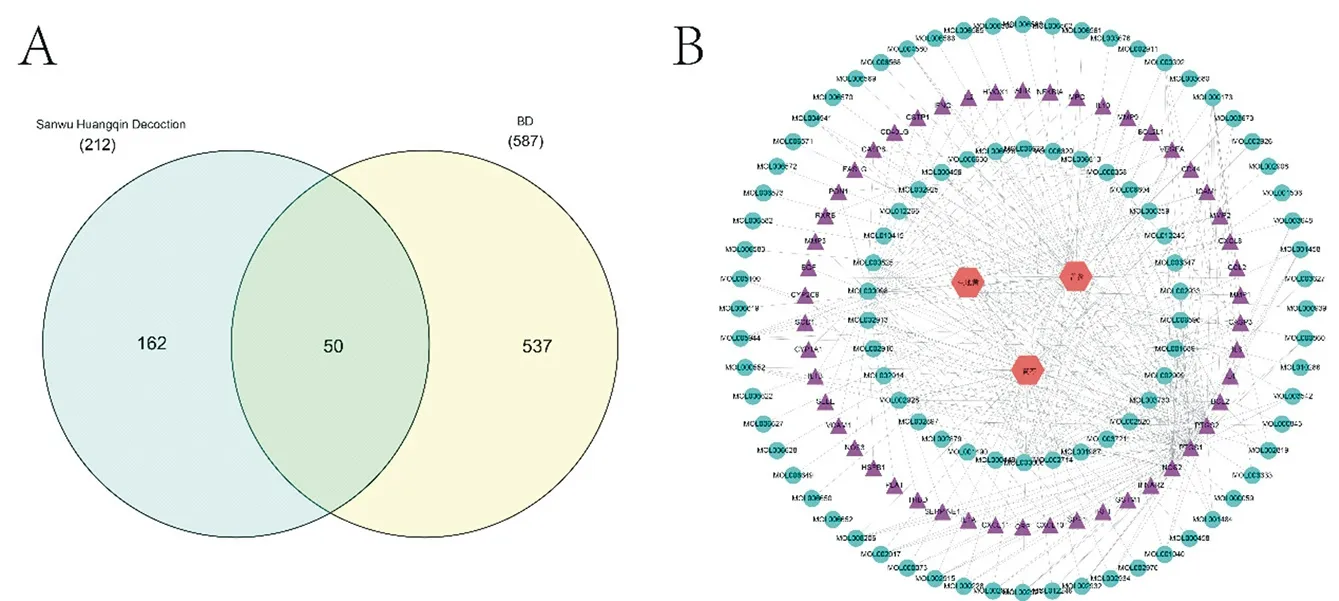
Figure 1. Drug disease target visualization network
3.3 Analysis of protein interaction network
50 drug disease target sites were imported into string website for protein protein interaction analysis, and the results were imported into Cytoscape software for network visualization, including 50 nodes and 656 edges. According to the intermediary centrality between the nodes, we grade and sort them. It can be seen that the top 10 targets of betweenness centrality in PPI network are Bcl-2, IL-6, PTGS2, CASP3, VEGFA, MPO, CXCL8, SOD1, HMOX1, CCL2. See Figure 2 and table 2.
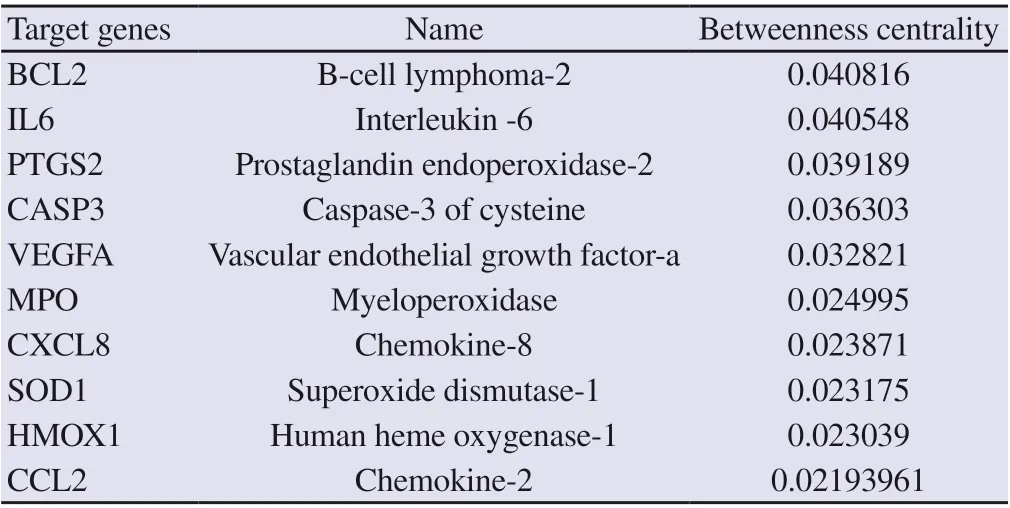
Table 2. Core targets in PPI network of Sanwu Huangqin Decoction

Table 2. Main active compounds of Sanwu Huangqin Decoction

Sophora flavescens MOL006571 anagyrine 62.01 0.24 Sophora flavescens MOL006572 1,4-diazaindan-type,alkaloid,flavascensine 34.64 0.24 Sophora flavescens MOL006573 13,14-dehydrosophoridine 65.34 0.25 Sophora flavescens MOL006582 5 ,9 -dihydroxymatrine 40.93 0.32 Sophora flavescens MOL006583 7,11-dehydromatrine 44.43 0.25 Sophora flavescens MOL006596 Glyceollin 97.27 0.76 Sophora flavescens MOL006604 (2S)-7-hydroxy-2-(4-hydroxyphenyl)-5-methoxy-8-(3-methylbut-2-enyl)chroman-4-one 48.09 0.39 Sophora flavescens MOL006613 kushenin 47.62 0.38 Sophora flavescens MOL006619 kushenol J 51.39 0.74 Sophora flavescens MOL006620 kushenol J_qt 50.86 0.24 Sophora flavescens MOL006622 kushenol O 42.41 0.76 Sophora flavescens MOL006623 kushenol,t 51.28 0.64 Sophora flavescens MOL006626 leachianone,g 60.97 0.4 Sophora flavescens MOL006627 Lehmanine 62.23 0.25 Sophora flavescens MOL006628 (+)-Lupanine 52.71 0.24 Sophora flavescens MOL006630 Norartocarpetin 54.93 0.24 Sophora flavescens MOL006649 sophranol 55.42 0.28 Sophora flavescens MOL006650 (-)-Maackiain-3-O-glucosyl-6'-O-malonate 48.69 0.52 Sophora flavescens MOL006652 trifolrhizin 48.53 0.74
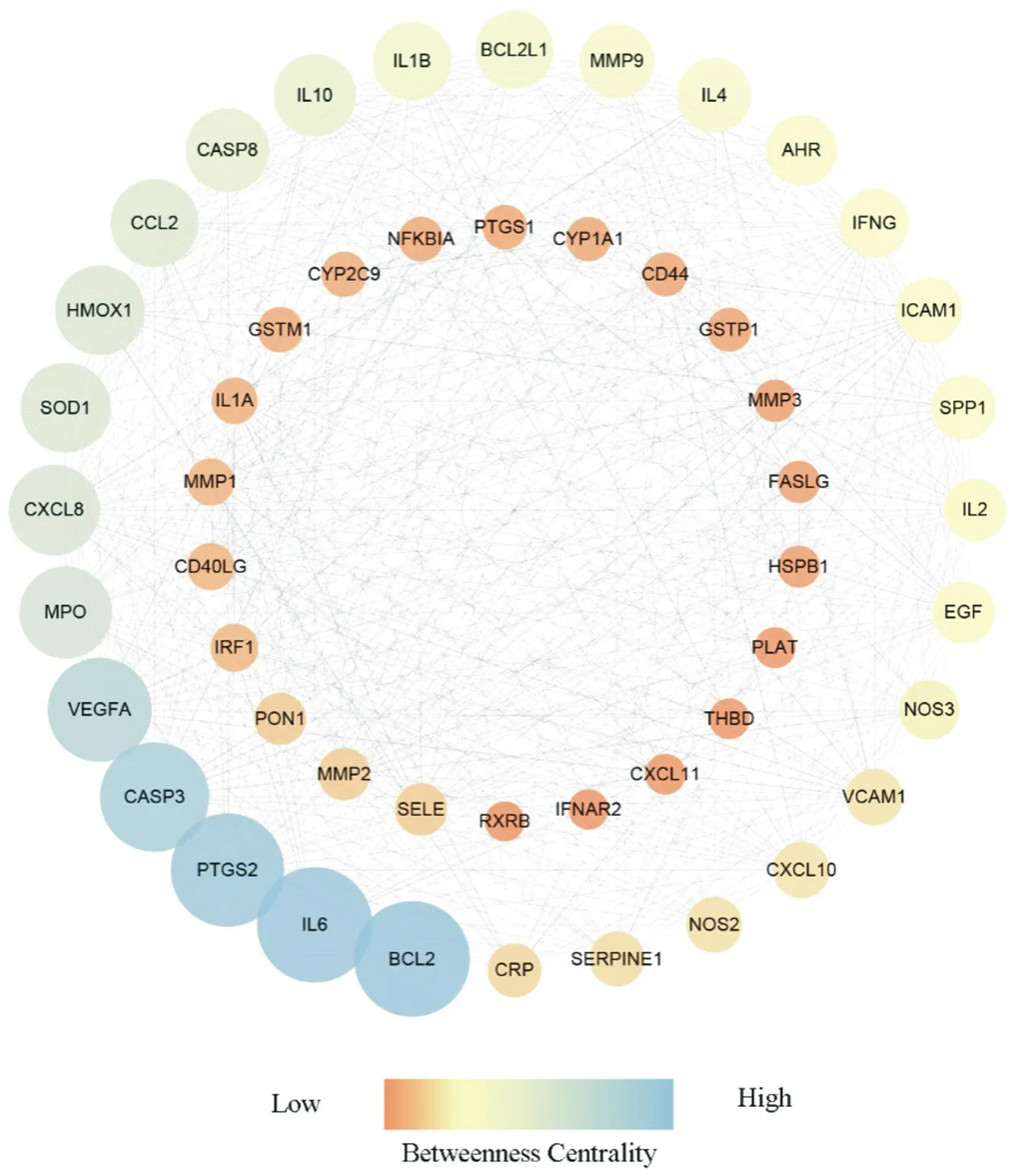
Figure 2. Visualization network of drug protein interaction analysis
3.4Go enrichment analysis
50 drug disease target sites were uploaded to the David database for go enrichment analysis. According to the threshold value of P < 0.05, 531 pieces of biological function information were obtained. The top 10 molecular functions, biological processes and cell components were plotted by R software. Among them, they are concentrated in the biological processes of lipopolysaccharide and bacterial source molecules, cell components such as membrane raft and extracellular matrix, cytokine activity and receptor ligand activity. See Figure 3.
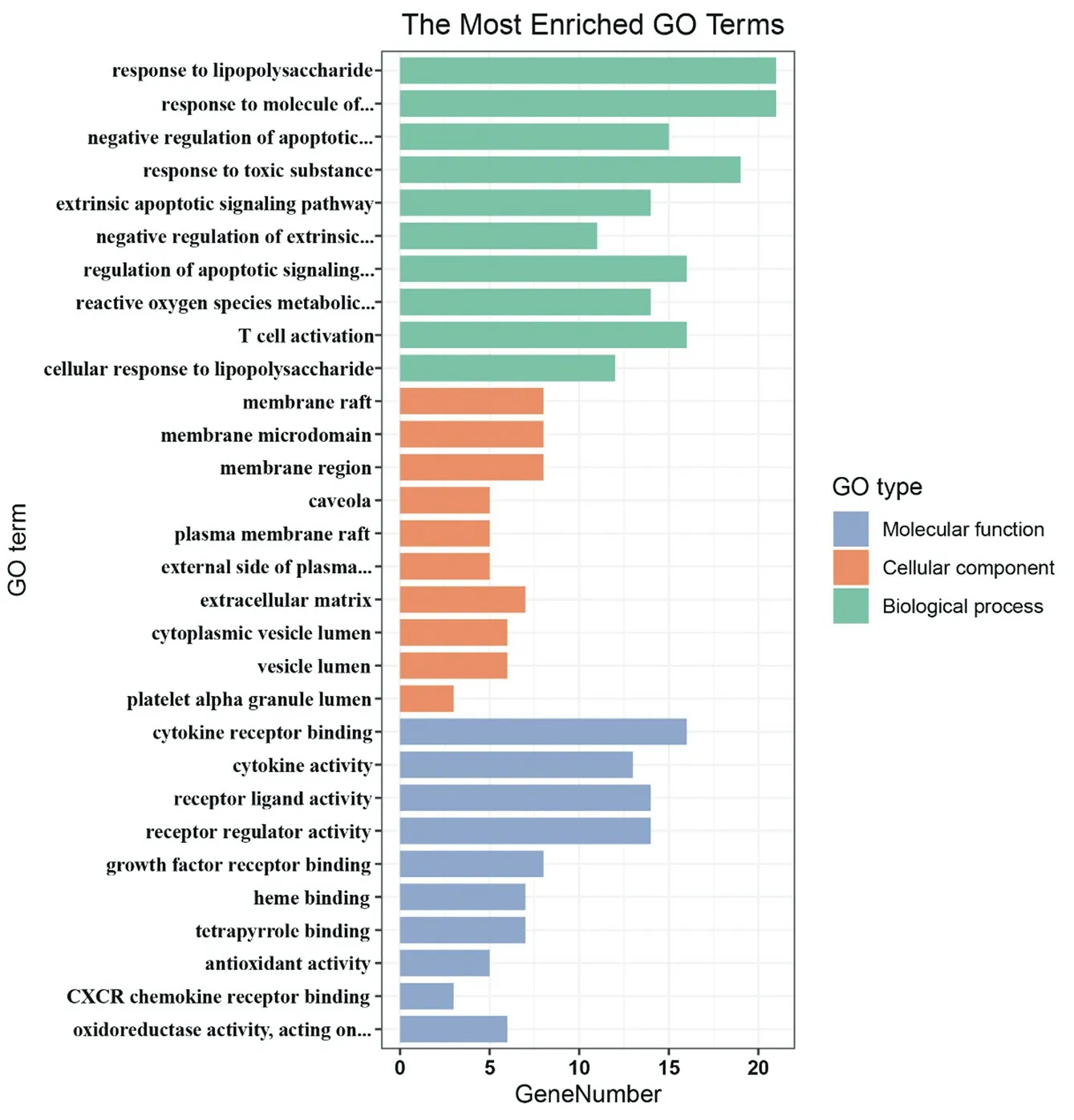
Figure 3. Go enrichment analysis of drug disease target
3.5 KEGG enrichment analysis
According to the threshold value of P < 0.05, KEGG was enriched to 96 signal pathways, among which the top 5 signal pathways were fluid shear stress and atherosclerosis, age-range signaling pathway in diagnostic complications, IL-17 signaling pathway, TNF signaling pathway, malaria, Chagas disease (American trypanosomias). See Figure 4.

Figure 4. Drug disease target analysis of KEGG enrichment
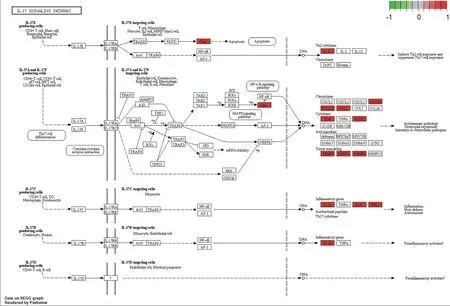
Figure 5.IL-17 signaling pathway
3.6 Detection of IL-17 signaling pathway related genes by RT-PCR
IL-17 signaling pathway plays an important role in the regulation of immune system inflammation. Therefore, this study carried out experimental verification on the expression of related genes in IL-17 signaling pathway. As shown in Figure 5, the gene marked in red is the target gene of "Sanwu Huangqin Decoction" for BD treatment. RT-PCR results showed that the expression of IL-4, IL-1 β, IL-6, inf - γ mRNA in the spleen of BD mice was significantly upregulated, and the expression of caspase 3 and caspase 8 mRNA was significantly down regulated. Compared with the blank group, the difference was statistically significant (P < 0.01). Compared with the model group, the expression of IL-4, IL-1 β, IL-6, inf - γ mRNA in the spleen of the mice in the Sanwu Huangqin Decoction group was significantly down regulated, and the expression of caspase 3 and caspase 8 mRNA was significantly up regulated, the difference was statistically significant (P < 0.01). See Figure 6.

Figure 6. Effect of Sanwu Huangqin Decoction on gene expression level of IL-17 signal pathway in spleen of BD mice
4. Discussion
BD was first reported by doctor Behcet of Turkey in 1937, so it is also called Behcet syndrome [11]. BD is mainly found in young adults aged 16-40, most of them are men, with a high mortality and disability rate [12]. The incidence of BD is worldwide, and has obvious racial differences and geographical clustering. Especially in the Mediterranean and Japan, the incidence rate of BD is relatively high, about 80~370/10 [13]. China is also a high incidence country of BD, with an incidence rate of 140/10 [14]. Based on the complex pathological mechanism of BD and the deficiency of current drug treatment, mining and developing new therapies is of great significance for current medical research and clinical treatment.
Compared with the inactive phase, the decrease of apoptosis is an important feature of BD in the active phase, and it also shows the up regulation of bcl-2 expression level in tissues [15]. Caspase family plays a key role in the process of cell apoptosis and degradation of downstream substrate. Under the group of cytokines, apoptosis is finally induced by a series of cascade reactions [16]. As the most critical apoptotic protease in the apoptosis cascade, caspase 3 can promote cell apoptosis by activating endonuclease and degrading DNA damage repair enzyme [17]. Caspase 8 is also an important member of caspase family. It was first cloned in jrukat lymphocytes by Fernandes et al[18]. As an important promoter of the membrane death receptor pathway (exogenous pathway), caspase 8 activates downstream caspase 3 by self cleavage, thus initiating apoptosis [19]. As a member of the classical Th2 cytokines, IL-4 can promote IgE conversion by inducing Th0 cells to Th2 cells, thus releasing inflammatory mediators. IFN - γ is a Th1 cytokine, which can promote the differentiation of CD4 + T cells into Th1 cells in hospitals, thus up regulating the levels of IL-2, IL-12 and TNF - α [20]. It was found that the levels of IL-4 and IFN - γ in the peripheral blood of BD patients were significantly up-regulated and correlated with BD [21-22]. IL-6 is a glycoprotein secreted by T cells, B cells and macrophages. As an important proinflammatory cytokine, IL-6 promotes the maturation of B cells and the effect of Zengqing NF KB by binding with receptors, so as to induce the maturation of other cytokines and play a pathogenic role [23]. IL-1 β is a multifunctional cytokine produced and released by activated macrophages, monocytes and other cells. It induces the production of matrix metalloproteinases (MMPs) through NF KB and MAPK signaling pathways, and is an important regulator of extracellular matrix decomposition [24].
In this study, we have retrieved 81 active compounds and 50 drug disease target of Sanwu Huangqin Decoction in the treatment of BD. Through the enrichment analysis of go and KEGG, the possible mechanism of Sanwu Huangqin Decoction in the treatment of BD was predicted and further verified by experiments. RT-PCR results showed that Sanwu Huangqin decoction could significantly down regulate the expression of IL-4, IL-1 β, IL-6, inf - γ mRNA, up regulate the expression of caspase 3 and caspase 8 mRNA, and then inhibit the activation of IL-17 signaling pathway.To sum up, as a classic prescription, on the one hand, we predict the possible mechanism of Sanwu Huangqin Decoction in the treatment of BD through network pharmacology, which provides certain theoretical basis for future experimental research. Secondly, we proved that Sanwu Huangqin decoction can treat BD by inhibiting the activation of IL-17 signal pathway. However, based on the characteristics of "multi-channel, multi-target" of traditional Chinese medicine, the follow-up mechanism research needs to be further carried out.
杂志排行
Journal of Hainan Medical College的其它文章
- Effects of virtual reality balance games combined with muscle strength training on balance function and motor ability of Parkinson's patients
- Epidemiological characteristics of 168 cases of COVID-19 in Hainan Island, tropical China: A descriptive study
- Survey and analysis of anxiety of 804 residents in Hainan during the COVID-19 epidemic
- Analysis of treatment strategies of traditional Chinese medicine for COVID-19 in tropical regions based on the pathogens of dampness and heat
- Evaluation of hepatic fibrosis parameter model and elastic modulus of liver and spleen for the diagnosis of hepatic fibrosis in chronic hepatitis b
- Effect of aripiprazole and olanzapine on the cognitive function in patients with schizophrenia
